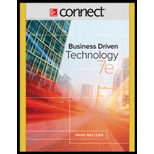
Explanation of Solution
Generic differentiated Strategies used by Organization:
Organizations follow one of Porter’s three generic strategies when entering a new market:
- Broad cost leadership- Broad strategies reach a large market segment.
- Broad differentiation- Focused strategies target a niche market.
- Focused strategy- Focused strategies concentrate on either cost leadership or differentiation.
Comparing traditional business competing on basis of price and MIS strategy:
Industry: Retail
Competing on basis of price:
The most common and most profitable digital business model is that of the traditional retailer. The traditional retailer profits by selling products and services directly to buyers at a mark-up from the actual cost.
For example, all bricks-and-mortar retailers employ this complementary business model online, and there are many online-only retailers that employ this business model. The retail strategies employed by digital retailers and physical retailers are often very different.
There are a lot of retail franchise business prospects among the greatest and most lucrative digital commercial model is that of the traditional retailer. This retailer profits can work as selling products and services straight to the buyers at a huge cost from the actual price...
Want to see the full answer?
Check out a sample textbook solution
Chapter 2 Solutions
Connect with LearnSmart Access Card for Business Driven Technology
- Identify the competitive advantage strategy applied in each of the following short scenarios. Motivate your choice based on your readings and the scenario. The Village bank has lowered their banking fees for customers by emailing them their monthly statements instead of printing them and posting them each month.arrow_forwardCompetitiveness, success and outcomes are among many factors that affect Entrepreneurs that’s why Entrepreneurs evaluate things differently and adopt more incorporate approaches when they analyze the businesses and opportunities discuss that briefly using both the Integrative Approach and the corporate perspective of entrepreneurship with 3-4 sentencesarrow_forwardArtificial intelligence isn’t just available to create a more customized experience for your customers. It can also transform the way your company operates from the inside. AI bots can be used as personal assistants to help manage your emails, maintain your calendar and even provide recommendations for streamlining processes. You can also program these AI assistants to answer questions for customers who call or chat online. These are all small tasks that make a huge difference by providing you extra time to focus on implementing strategies to grow the business.” Analyse ANY FIVE (5) functional areas of management (departments) in the organisation you are employed at or an organisation of your choice and evaluate the managerial success or challenges that could arise if you implement AI in each department analysed.arrow_forward
- Consider the opportunity of applying for a position with a neworganization. What would you like the employer to know aboutyou? How does your Strengths Test accent your potentialwithin that organization? Please clarify your responsethrough examples.arrow_forwardQ1: Business concepts and models were revolutionized as a result of the introduction of technology. This is because technology gave a new and better approach on how to go about with business. It provided a faster, more convenient, and more efficient way of performing business transactions. Explain technology knowledge codification along with all possible technology related roles that play an imperative responsibility to achieve the organizational goals. Justify your answer with some real-time examples and diagrams (if necessary).arrow_forwardExamine the possibility of obtaining employment with a new company. What information would you want your employer to know about you if you were hired? When you take the Strengths Test, how does it highlight your potential inside that company? Describe your answer with specific examples if possible.arrow_forward
- Topic 10: Industry Revolution 4.0/5.0 The I.R 4.0 is a highly talked about initiative which has garnered the attention of government and private agencies. I.R 4.0 has been put in the limelight due to its significant positive impact on different aspects, such as community development and business growth. Procedure: 1. Put yourself in a situation where you are invited by a top and well-known company for an interview. 3. The job position is based on your programme, which is, hotel management programme, you are interviewing for a position as what? 4. The employer/interviewer will ask you questions on what is I.R 4.0? and what are the elements of I.R 4.0 that you will bring for the company if you are hired? Words: 150 - 300 wordsarrow_forwardAmazon is the eCommerce titan the industry has been waiting for. Net sales have been rising since 2014. In 2016, Amazongrabbed 70% of the total sales, and service sales have only been growing since then. For all those wondering if eCommerce is profitable, the answer lies in Amazon’s undeniable success, so much so that the “Amazon Effect” has even entered the lexicon of industry analysts. In terms of operating income, growth has been driven by high margins from service sales. Revenue sources, AWS services, and Amazon Prime subscriptions have been rising at phenomenal rates, too. The revenue generation model is a critical component of the eCommerce business plan. Anybody looking to understand how to start a successful eCommerce business needs to understand that making money is the key to thriving and not just surviving. The eCommerce business model unlocks value and is the key driver of value. It makes all the difference betweena unicorn and a failed start-up. Scaling up to a…arrow_forwardAmazon is the eCommerce titan the industry has been waiting for. Net sales have been rising since 2014. In 2016, Amazongrabbed 70% of the total sales, and service sales have only been growing since then. For all those wondering if eCommerce is profitable, the answer lies in Amazon’s undeniable success, so much so that the “Amazon Effect” has even entered the lexicon of industry analysts. In terms of operating income, growth has been driven by high margins from service sales. Revenue sources, AWS services, and Amazon Prime subscriptions have been rising at phenomenal rates, too. The revenue generation model is a critical component of the eCommerce business plan. Anybody looking to understand how to start a successful eCommerce business needs to understand that making money is the key to thriving and not just surviving. The eCommerce business model unlocks value and is the key driver of value. It makes all the difference betweena unicorn and a failed start-up. Scaling up to a…arrow_forward
 Principles of Information Systems (MindTap Course...Computer ScienceISBN:9781305971776Author:Ralph Stair, George ReynoldsPublisher:Cengage Learning
Principles of Information Systems (MindTap Course...Computer ScienceISBN:9781305971776Author:Ralph Stair, George ReynoldsPublisher:Cengage Learning Information Technology Project ManagementComputer ScienceISBN:9781337101356Author:Kathy SchwalbePublisher:Cengage Learning
Information Technology Project ManagementComputer ScienceISBN:9781337101356Author:Kathy SchwalbePublisher:Cengage Learning Principles of Information Systems (MindTap Course...Computer ScienceISBN:9781285867168Author:Ralph Stair, George ReynoldsPublisher:Cengage Learning
Principles of Information Systems (MindTap Course...Computer ScienceISBN:9781285867168Author:Ralph Stair, George ReynoldsPublisher:Cengage Learning


